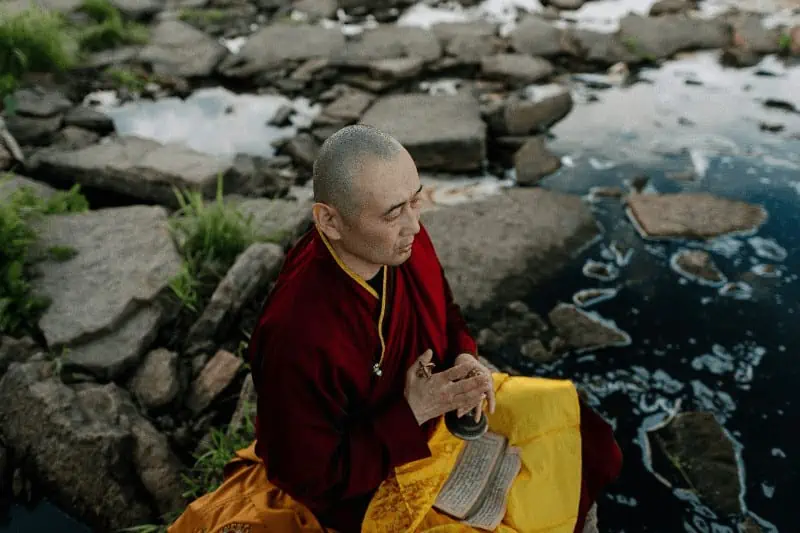Any person who practices yoga surely knows that the teachings of a yogic path extend far beyond the mat. Jnana yoga, the yoga of knowledge, is an essential practice stage for any dedicated yogi. This ancient practice offers a multitude of paths to spiritual growth and self-discovery.
In my personal experience as someone who began yoga for a physical workout, this insight may creep up on me slowly over time. But at some point, I found my thoughts shifting toward yoga’s more profound metaphysical and historical aspects. Within this diverse practice, there are many paths of yoga that offer specific benefits to your body, heart, and mind. Jnana yoga focuses on the latter.
Traditionally, a yogic practice has four main paths: Karma, Bhakti, Raja, and Jnana. Each path serves a specific purpose on the quest toward spiritual enlightenment. Jnana Yoga, the path of wisdom, encourages the pursuit of knowledge and absolute truth.
Are you, like me, curious about yoga’s “hows” and “whys”? Are you considering taking the next step on your spiritual path? Get ready to deepen your connection to this profound practice! Here at The Yoga Nomads, we cover all the bases to support you at any stage on your yogic path.
This guide will delve into the intricacies of Jnana Yoga, exploring its principles and potential benefits.
Contents
- 1 What is Jnana Yoga?
- 2 Jnana Yoga’s Key Principles Explained
- 3 Steps and Practices in Jnana Yoga
- 4 The Yoga Mind: 52 Essential Principles of Yoga Philosophy to Deepen Your Practice
- 5 The Four Mahavakyas’ Role in Jnana Yoga
- 6 Impact of Ego and Knowledge in Jnana Yoga
- 7 Benefits of a Jnana Yoga Practice
- 8 Wrapping Up Jnana Yoga
What is Jnana Yoga?
Jñāna yoga (pronounced “nyah-na”) is a journey towards knowledge and self-realization deeply rooted in Hindu philosophy; people who dedicate themselves to this yogic path are known as jnanis.
Distinct from other forms of yoga that focus on physical postures or breath control, Jñāna Yoga emphasizes the pursuit of awareness and truth through meditation, deep contemplation, and self-study. Jñāna yoga encourages practitioners to delve into their inner selves and achieve enlightenment through insight and perception; this yoga philosophy promotes gaining experiential knowledge, not just practice.
For example, I can recall being in a yoga class where the teacher incorporated philosophy-based terminology — from the yamas and niyamas, for example — and found myself contemplating the meaning and realizing, “This sounds familiar to a situation in my life!” If you can relate to this scenario, well, that is the essence of Jnana Yoga!
However, Jñāna Yoga is not just about acquiring correct knowledge; it’s about applying this wisdom for self-realization and spiritual liberation. This form of yoga can be an enriching experience for those seeking a deeper connection with their inner selves through devotion and exploration of the mind.
Jnana Yoga’s Key Principles Explained
Self-Realization in Jnana Yoga
Rather than focusing on physical postures, Jnana yoga is a journey towards knowing oneself and the meaning of reality. Jnana yoga philosophy teaches us to look within, discover our true nature, and foster oneness with the divine through study, contemplation, and devotion.
For example, jnanis often use information from various sources and ancient scriptures to pursue the subject of “atman” or inner self, which is central to jñāna yoga philosophy. Dedicated study and discussion of scripture encourage monks and yogis alike to connect with their supreme self or core being.
Discernment and Detachment
Next are discernment and detachment — two core teachings in jñāna yoga. These qualities help us separate truth from illusion.
Discernment, or “viveka,” involves using your intellect to understand reality, a principle fundamental to jñāna yoga. It’s about knowing the difference between what is real and unreal, what is the “self” versus non-self.
Monks often practice detachment, or “vairagya,” which is all about letting go of worldly attachments to bring peace and clarity. This also includes mental detachment, letting go of thoughts bound to the material world. Practicing meditation helps clear the clutter in our minds, making room for true information and knowledge.
Unity Consciousness
Like many spiritual paths, including Hinduism, Jnana yoga aims to attain oneness with God. This goal of divine unity is rooted in a school of Indian philosophy called advaita vedanta, which means non-duality. According to this philosophy, there is no separation between the individual soul (atman) and ultimate reality (Brahman or God). The contemplation and study of Jnana yoga helps a yogi realize this true knowledge and ultimately experience universal oneness.
This concept goes beyond merely obtaining and comprehending information; it’s about realizing that everything in the world is interconnected at a deeper level.
In practicing jnana yoga, jnanis strive for samadhana – a single-pointed focus on the ultimate goal: unity of the supreme self with universal consciousness. When realized, this true knowledge brings liberation or “moksha,” freeing us from the cycle of birth and death and bringing ultimate spiritual liberation.
Speaking about death and rebirth might sound a bit heavy, not to mention all these abstruse philosophical terms
Does this all sound a bit abstruse to you? It doesn’t have to be — start simple! I realized I feel connected to the universal consciousness by meditating on Loving Kindness and Great Compassion. These types of meditations are reminders that all living beings want the same things: to be safe and loved. Try an app like Headspace, which has several guided meditations to choose from.
Steps and Practices in Jnana Yoga

Initial Steps to Begin Your Jnana Yoga Practice
Jnana Yoga, often called the yogic path for the intellectual monk, starts with reading scriptures to gather world information. It’s recommended to begin this study under the direction of a head monk or trusted teacher who can provide vital information and philosophical discussion to guide you through your spiritual journey.
- Reading ignites reflection and contemplation.
- Reflection leads to meditation.
- Meditation opens the mind to receive correct knowledge and connection to universal consciousness.
This dedicated approach is vital in this spiritual practice.

The Yoga Mind: 52 Essential Principles of Yoga Philosophy to Deepen Your Practice
See latest priceThe Four Pillars of Wisdom
Before diving into Jnana Yoga, there are four qualifications known as the Four Pillars of Wisdom:
- Viveka: discrimination to distinguish between the real and non-real.
- Vairagya: detachment from worldly desires.
- Shatsampat: six virtues that bring clarity of mind to better see through the illusions of the material world. The six virtues include shama (calmness of mind), dama (control over senses), uparati (renunciation of worldly desires), titiksha (endurance through common suffering), shraddha (faith in one’s teacher, scriptures, and the spiritual path), and lastly samadhana (the complete focus of the mind).
- Mumukshutva: an intense longing for liberation from suffering.
These pillars stand tall on the path of any aspiring yogi, each stage building upon the previous one.
Core Practices of Jnana Yoga
Once past the pillars, you will find three core practices:
- Sravana: Hearing scriptures and studying the subject of non-dualism, atman, and universal oneness under a guru or teacher.
- Manana: Reflecting on what you’ve learned about the teachings of non-duality.
- Nididhyasana: Deep meditation on the inner self includes reciting foundational mantras from The Upanishads, the Mahavakyas.
Following these stages aren’t just steps along a specific spiritual path; they’re an approach to life itself. Whether at work or remembering when I was in school, I am aware of my mind constantly taking in new information, which it then processes and synthesizes so that I can apply it to my job or life. Applying the same curious approach to yoga elevated my practice in ways I never anticipated!
Consistency is Key
Consistency is crucial for progress in Jnana yoga, just like karma yoga or any other yogic path.
- Regular study sharpens discrimination skills.
- Steady reflection fosters detachment.
- Persistent meditation cultivates devotion.
Mastering these steps isn’t a sprint; it’s more like a marathon — nobody becomes a head monk overnight! This is all about experiential knowledge, right? I get out of it what I put in, and so will you. So remember, jnanis, keep at it!
The Four Mahavakyas’ Role in Jnana Yoga
Jnana Yoga, the path of knowledge, heavily relies on four sacred mantras called the Mahavakyas. These are profound teachings from the Upanishads that hold immense significance for jnanis.

Each Mahavakya’s Unique Contribution
Each Mahavakya provides a unique perspective on our supreme self and upholds the non-dualistic view of the advaita vedanta philosophy in Hinduism.
- “Prajnanam Brahma” (Consciousness is Brahman): This mantra teaches us that our consciousness is divine.
- “Aham Brahmasmi” (I am Brahman): This phrase helps us realize our divine nature and oneness with God.
- “Tat Tvam Asi” (You are That): This affirmation proclaims that each individual is part of the ultimate reality.
- “Ayam Atma Brahma” (This Self or Soul is Brahman): Its meaning signifies that our soul aligns with God.
I’ve found that the majority of standard yoga studio classes don’t include chanting — I had never actually sat and chanted a mantra before attending my yoga teacher training! I wish I’d known before that these sacred mantras are widely accessible online. If you’re in need of some guidance or prefer just to listen rather than chant, you can find recordings of the Mahavakyas online, such as this Tat Tvam Asi video.
Realization of the “Great Sayings”
Understanding these phrases isn’t about memorizing scripture or strings of words. Monks spend years in contemplation to grasp their essence. For example, an old monk might ponder ‘Aham Brahmasmi’ until he genuinely feels one with God.
Ready to dive into these sacred mantras? Here is a wonderful English translation of the Mahavakya or “Great Sayings.”
Mahavakyas and Self-realization
The journey towards self-realization involves peeling off veils of ignorance. And here, the Mahavakyas play a crucial role. They act like torches, illuminating our path toward realizing the absolute truth beyond physical existence — our Supreme Self.
I’ve grown to love mantra chanting as my yoga practice has evolved. It gives us yogis another opportunity to connect with each other through shared experiences, emphasizing the oneness of this devotional practice.
Impact of Ego and Knowledge in Jnana Yoga
Ego’s Role in Progress Hindrance
The ego or ahamkara, that part of you that sets your identity apart from others, can be a stumbling rock on your jnana yoga journey. It keeps your mind focused only on your individual self, not allowing you to experience unity with God, thus hindering your progress toward self-realization.
The ego feeds off ignorance and keeps you chained to samsara, the endless cycle of suffering in the material world. Imagine it as a foggy lens, distorting the clear view of your true self.
Knowledge: The Transcendence Tool
The information discovered through Jnana Yoga isn’t just about facts or data; we’re talking about experiential knowledge here. This is the knowing felt deep within your bones, not just in your thinking mind.
As a yoga teacher, nothing brings me more joy than when students share with me that they experienced an “a-Ha!” moment during a class, having connected some philosophical insight to a specific posture or situation in their life. That “lightbulb” realization of fusing knowledge with experience, when the foundational concepts of yoga really hit home — that is the transcendental power of yoga knowledge!
In Jnana Yoga, knowledge is like a sharp sword slicing through the web of ego and veils of ignorance. Correct knowledge learned from ancient scripture paves the way for divine connection and liberation from suffering.
Balancing Ego and Knowledge
Now comes the tricky part: the need to strike a balance between ego and knowledge. Think of it like walking on a tightrope; too much ego, you fall one way; too much reliance on mere intellectual knowledge without experience, you tumble the other way.
True wisdom lies in using this correct knowledge as a tool for awareness while keeping the ego in check. This balance leads to an intimate encounter with the supreme self or God.
When I think back to beginning my yoga teacher training, it was easy to get wrapped up in memorizing all the correct Sanskrit names for all of the postures or cramming in as much historical information as possible into my mind. But for me, the real learning happened when I let go of all those external expectations and focused on deepening my personal practice. In true Jnana Yoga, your reasoning for acquiring more knowledge is for your own self-discovery.
Remember, Jnana Yoga isn’t just about collecting information and understanding how to use this wisdom for spiritual growth. It’s about knowing yourself beyond the surface and recognizing that spark of divinity within!
Benefits of a Jnana Yoga Practice
Jnana Yoga brings clarity of mind and emotional stability through its profound teachings and practices. It’s a path to inner peace and self-realization.

Mental Clarity Through Consistent Practice
Engaging in regular Jnana Yoga practice sharpens the mind. This form of yoga, known as the path of knowledge, encourages deep contemplation. As you progress through the various stages of Jnana Yoga, you’ll experience:
- Increased focus
- Better decision-making abilities
- Enhanced memory retention
- Greater peace of mind
Emotional Stability
Jnana Yoga isn’t just about intellectualizing the information you learn. It’s a sadhana, a daily spiritual practice that also serves to steady your emotions. Yogis who follow the Jnana Yoga path can expect the following:
- Reduced stress levels
- Less susceptibility to mood swings through practicing non-attachment
- Greater emotional resilience
Inner Peace and Self-Realization Through Understanding
Through a deeper understanding of oneself and the world around us, Jnana Yoga leads us towards liberation from suffering. This form of yoga teaches oneness with all existence, meaning:
- Improved sense of well-being
- Heightened awareness
- A more profound connection with one’s true nature
- Feeling aligned with one’s life purpose
While Jnana Yoga focuses on gaining knowledge, this practice transcends the intellectual mind. Dedicated, consistent practice brings transformative outcomes for your physical, emotional, and spiritual well-being.
Wrapping Up Jnana Yoga
Jnana Yoga, emphasizing knowledge and understanding, offers a unique path to spiritual enlightenment. The practice’s fundamental principles and the role of the Four Mahavakyas converge to help people overcome ego and ignorance.
The journey towards self-realization through Jnana Yoga is not easy, but it is rewarding. It requires commitment, patience, and an open mind ready to embrace profound truths about existence. And these qualities, in my humble opinion, only serve to improve every other aspect of life!
Are you prepared to embark on this enlightening journey? You don’t have to be an ascetic monk to practice Jnana Yoga; with the proper devotion, any yogi can unlock numerous benefits beyond the mat and apply them to daily life.
Frequently Asked Questions
What are the fundamental principles of Jnana Yoga?
The fundamental principles of Jnana Yoga involve seeking true knowledge about oneself and reality through focused study and deep contemplation. The ultimate goal is to learn the discrimination between what is eternal (Brahman) and what is illusion (Maya).
How does one practice Jnana Yoga?
Practicing Jnana yoga involves several steps, including learning from scriptures or through discussion with a teacher (sravana), reflecting on these teachings (manana), and meditating deeply on these truths (nididhyasana).
What are the Four Mahavakyas in Jnana Yoga?
The Four Mahavakyas or “great sayings” in Jnana yoga are mantras found in the Upanishads. They serve as guiding principles for grasping ultimate reality and emphasize the non-dualistic approach of the advaita vedanta philosophy.
How does ego affect our understanding of Jnana yoga?
The ego can cloud our perception of reality in Jnana Yoga. Overcoming ego allows us to see things as they are without personal bias or illusion. Mental detachment from our self-directed thoughts is crucial to gaining true knowledge.
What benefits can I experience from practicing Jnana Yoga?
Practicing jnana yoga can lead to greater self-awareness, peace and clarity of mind, heightened emotional stability, and self-realization or enlightenment. These benefits are reserved not only for monks and scholars but for any person who desires to further their spiritual journey.


